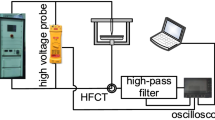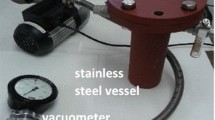Abstract
The insulation of oil-immersed paper bushing in a transformer bushing is mainly made of multi-layer paper insulation. This work investigates the whole process from discharge initiation to breakdown of an oil-paper insulation model. On the basis of establishing a laminated insulation test sample of a capacitive bushing immersed in oil paper as found in an analogue transformer, a constant voltage method was used to pressure-test to breakdown of the insulation paper. After the analysis of carbon marks on the surface, internal fibre structure, surface functional groups, and surface element content, the results show that: during each stage of partial discharge, the area of carbon marking on the surface of the insulation paper decreases gradually from high the voltage electrode to the ground electrode on a layer-by-layer basis, the extent of damage to the fibre surface and molecular chain is reduced, and the tendency to carbonisation is weakened. With increasing partial discharge time, the area of the carbon mark on the surface of the insulation paper increased layer-by-layer, the damage to the fibre surface and molecular chain increased, and the tendency to carbonisation increased. These results provide a guidance to those interested in the partial discharge mechanism of multi-layer insulation paper.











Similar content being viewed by others
References
Bouaicha A, Fofana I, Farzaneh M, Setayeshmehr A (2009) Dielectric spectrocopy techniques as quality control tool: a feasibility study. IEEE Electr Insul Mag 25:6–14
Dai J, Wang ZD, Jarman P (2010) Creepage discharge on insulation barriers in aged power transformers. IEEE Trans on Dielectr Electr Insul 17:1327–1335
Edwards HG, Farwell DW, Webster D (1997) FT Raman microscopy of untreated natural plant fibres. Spect Acta Part A Mol Biomol Spect 53:2383–2392
Gao M, Zhang QG, Ding YQ, Wang TL, Ni HL, Yuan WX (2017) Investigation on bubbling phenomenon in oil-paper insulation. IEEE Trans on Dielectr Electr Insul 24:2362–2370
Gupta BK, Densley J, Narang A (2009) Condition assessment of oil-paper insulated bushings. In IEEE electrical insulation conference, pp 283–286
Hinterstoisser B, Salmenb L (2000) Application of dynamic 2D FTIR to cellulose. Vib Spect 22:111–118
Li J, Du BX, Kong XX, Zhang JG (2016) Surface and interface charge behaviour in multi-layer oil-paper insulation under DC voltage application. In: IET international conference on AC and DC power transmission
Liao RJ, Yan JM, Yang LJ, Zhu MZ, Sun CX (2011) Characteristics of partial discharge-caused surface damage for oil-impreganted insulation paper. In: Proceeding of the CSEE, vol 31, pp 129–137
Massingue F, Meijer S, Agoris PD, Smit JJ (2006). Partial discharge pattern analysis of modeled insulation defects in transformer insulation. In: International symposium on electrical insulation, pp 542–545
Mitchinson PM, Lewin PL, Chen G, Jarman P (2008) A new approach to the study of surface discharge on the oil-pressboard interface. In: IEEE international conference on dielectric liquid, pp 1–4
Mitchinson PM, Lewin PL, Strawbridge BD, Jarman P (2010) Tracking and surface discharge at the oil-pressboard interface. IEEE Electr Insul Mag 26:35–41
Paul G, Paul W (2006) Identification of cellulosic fibres by FTIR spectroscopy: differentiation of flax and hemp by polarized ATR FTIR. Stud in Cons 48:205–211
Przybylek P, Moranda H, Walczak K, Moscicka-Grzesiak H (2012) Can the bubble effect occur in an oil impregnated paper bushing. IEEE Trans on Dielectr and Electr Insul 19:1879–1883
Smith DJ, Mcmeekin SG, Stewart BG, Wallace PA (2012) A variable frequency model of a transformer bushing with localised moisture content. In: Electric insulation and dielectric phenomena, pp 451–454
Smith DJ, Mcmeekin SG, Stewart BG, Wallace PA (2013) A dielectric frequency response model to evaluate the moisture content within an oil impregnated paper condenser bushing. IET Sci Meas Technol 7:223–231
Wankowicz J, Bielecki J, Szrot M, Subocz J, Malewski R (2010) HV bushing failure in service, diagnostics and modeling of oil-type bushings. In: Cigre Plenary Session: pp 22–27
Wei JQ, Chen YC, Wang GZ, Rong ZH, Diao CJ (2013). Development rules of inter-turn partial discharge defects on oil-paper insulation. In: IEEE international conference on solid dielectric, pp 975–978
Xu W, Mu B, Wang A (2017) Morphology control of polyaniline by dopant grown on hollow carbon fibers as high-performance supercapacitor electrodes. Cellulose 24:1–14
Yan JM, Liao RJ, Yang LJ, Hao J, Sun CX (2011) Analysis of damage products of oil-impregnated insulation paper caused by partial discharge. Trans Chin Electrotechn Soc 26:184–191
Author information
Authors and Affiliations
Corresponding author
Additional information
Publisher's Note
Springer Nature remains neutral with regard to jurisdictional claims in published maps and institutional affiliations.
Rights and permissions
About this article
Cite this article
Wang, Y., Luo, Y., Wang, Y. et al. Partial discharge damage mechanisms in laminated oil-paper insulation. Cellulose 26, 5707–5718 (2019). https://doi.org/10.1007/s10570-019-02470-5
Received:
Accepted:
Published:
Issue Date:
DOI: https://doi.org/10.1007/s10570-019-02470-5




